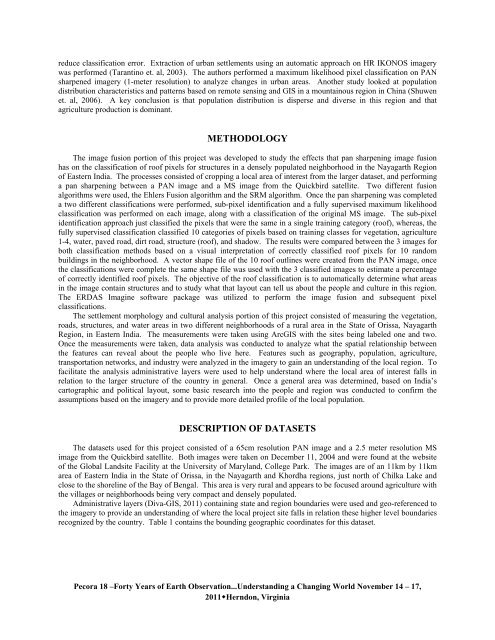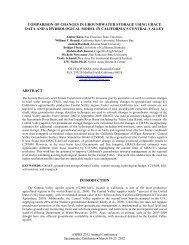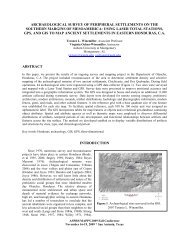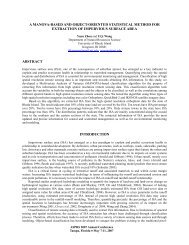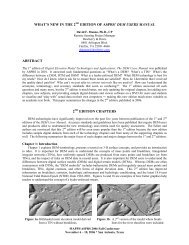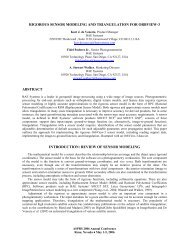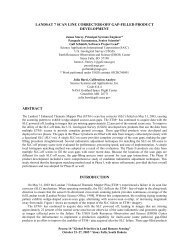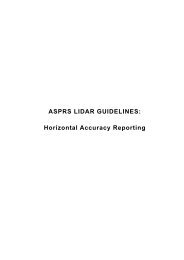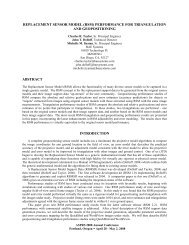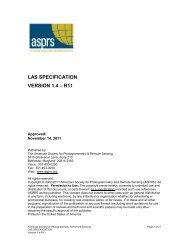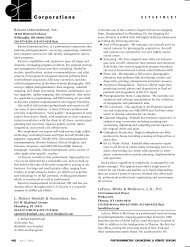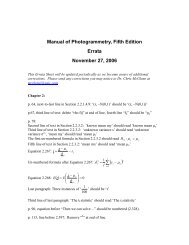using image fusion and classification to profile a human ... - asprs
using image fusion and classification to profile a human ... - asprs
using image fusion and classification to profile a human ... - asprs
You also want an ePaper? Increase the reach of your titles
YUMPU automatically turns print PDFs into web optimized ePapers that Google loves.
educe <strong>classification</strong> error. Extraction of urban settlements <strong>using</strong> an au<strong>to</strong>matic approach on HR IKONOS <strong>image</strong>ry<br />
was performed (Tarantino et. al, 2003). The authors performed a maximum likelihood pixel <strong>classification</strong> on PAN<br />
sharpened <strong>image</strong>ry (1-meter resolution) <strong>to</strong> analyze changes in urban areas. Another study looked at population<br />
distribution characteristics <strong>and</strong> patterns based on remote sensing <strong>and</strong> GIS in a mountainous region in China (Shuwen<br />
et. al, 2006). A key conclusion is that population distribution is disperse <strong>and</strong> diverse in this region <strong>and</strong> that<br />
agriculture production is dominant.<br />
METHODOLOGY<br />
The <strong>image</strong> <strong>fusion</strong> portion of this project was developed <strong>to</strong> study the effects that pan sharpening <strong>image</strong> <strong>fusion</strong><br />
has on the <strong>classification</strong> of roof pixels for structures in a densely populated neighborhood in the Nayagarth Region<br />
of Eastern India. The processes consisted of cropping a local area of interest from the larger dataset, <strong>and</strong> performing<br />
a pan sharpening between a PAN <strong>image</strong> <strong>and</strong> a MS <strong>image</strong> from the Quickbird satellite. Two different <strong>fusion</strong><br />
algorithms were used, the Ehlers Fusion algorithm <strong>and</strong> the SRM algorithm. Once the pan sharpening was completed<br />
a two different <strong>classification</strong>s were performed, sub-pixel identification <strong>and</strong> a fully supervised maximum likelihood<br />
<strong>classification</strong> was performed on each <strong>image</strong>, along with a <strong>classification</strong> of the original MS <strong>image</strong>. The sub-pixel<br />
identification approach just classified the pixels that were the same in a single training category (roof), whereas, the<br />
fully supervised <strong>classification</strong> classified 10 categories of pixels based on training classes for vegetation, agriculture<br />
1-4, water, paved road, dirt road, structure (roof), <strong>and</strong> shadow. The results were compared between the 3 <strong>image</strong>s for<br />
both <strong>classification</strong> methods based on a visual interpretation of correctly classified roof pixels for 10 r<strong>and</strong>om<br />
buildings in the neighborhood. A vec<strong>to</strong>r shape file of the 10 roof outlines were created from the PAN <strong>image</strong>, once<br />
the <strong>classification</strong>s were complete the same shape file was used with the 3 classified <strong>image</strong>s <strong>to</strong> estimate a percentage<br />
of correctly identified roof pixels. The objective of the roof <strong>classification</strong> is <strong>to</strong> au<strong>to</strong>matically determine what areas<br />
in the <strong>image</strong> contain structures <strong>and</strong> <strong>to</strong> study what that layout can tell us about the people <strong>and</strong> culture in this region.<br />
The ERDAS Imagine software package was utilized <strong>to</strong> perform the <strong>image</strong> <strong>fusion</strong> <strong>and</strong> subsequent pixel<br />
<strong>classification</strong>s.<br />
The settlement morphology <strong>and</strong> cultural analysis portion of this project consisted of measuring the vegetation,<br />
roads, structures, <strong>and</strong> water areas in two different neighborhoods of a rural area in the State of Orissa, Nayagarth<br />
Region, in Eastern India. The measurements were taken <strong>using</strong> ArcGIS with the sites being labeled one <strong>and</strong> two.<br />
Once the measurements were taken, data analysis was conducted <strong>to</strong> analyze what the spatial relationship between<br />
the features can reveal about the people who live here. Features such as geography, population, agriculture,<br />
transportation networks, <strong>and</strong> industry were analyzed in the <strong>image</strong>ry <strong>to</strong> gain an underst<strong>and</strong>ing of the local region. To<br />
facilitate the analysis administrative layers were used <strong>to</strong> help underst<strong>and</strong> where the local area of interest falls in<br />
relation <strong>to</strong> the larger structure of the country in general. Once a general area was determined, based on India’s<br />
car<strong>to</strong>graphic <strong>and</strong> political layout, some basic research in<strong>to</strong> the people <strong>and</strong> region was conducted <strong>to</strong> confirm the<br />
assumptions based on the <strong>image</strong>ry <strong>and</strong> <strong>to</strong> provide more detailed <strong>profile</strong> of the local population.<br />
DESCRIPTION OF DATASETS<br />
The datasets used for this project consisted of a 65cm resolution PAN <strong>image</strong> <strong>and</strong> a 2.5 meter resolution MS<br />
<strong>image</strong> from the Quickbird satellite. Both <strong>image</strong>s were taken on December 11, 2004 <strong>and</strong> were found at the website<br />
of the Global L<strong>and</strong>site Facility at the University of Maryl<strong>and</strong>, College Park. The <strong>image</strong>s are of an 11km by 11km<br />
area of Eastern India in the State of Orissa, in the Nayagarth <strong>and</strong> Khordha regions, just north of Chilka Lake <strong>and</strong><br />
close <strong>to</strong> the shoreline of the Bay of Bengal. This area is very rural <strong>and</strong> appears <strong>to</strong> be focused around agriculture with<br />
the villages or neighborhoods being very compact <strong>and</strong> densely populated.<br />
Administrative layers (Diva-GIS, 2011) containing state <strong>and</strong> region boundaries were used <strong>and</strong> geo-referenced <strong>to</strong><br />
the <strong>image</strong>ry <strong>to</strong> provide an underst<strong>and</strong>ing of where the local project site falls in relation these higher level boundaries<br />
recognized by the country. Table 1 contains the bounding geographic coordinates for this dataset.<br />
Pecora 18 –Forty Years of Earth Observation...Underst<strong>and</strong>ing a Changing World November 14 – 17,<br />
2011Herndon, Virginia


